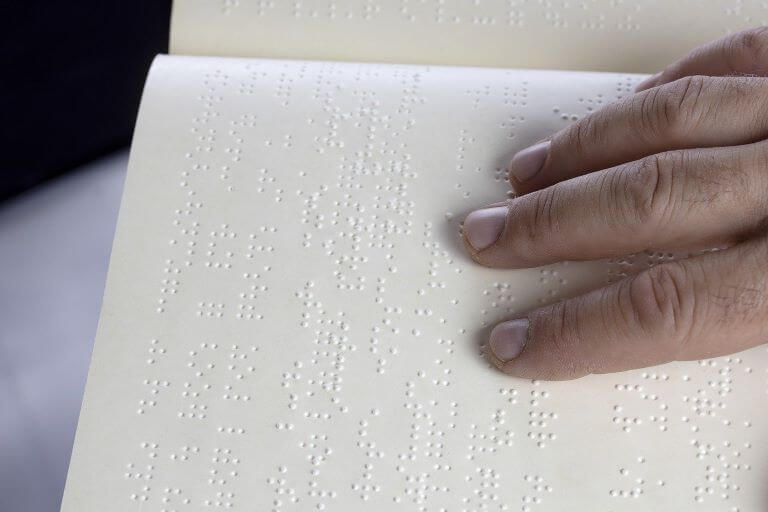According to World Health Organization, about 1.3 billion people live with some level of vision impairment and 36 million are blind. For sighted individuals, using an everyday consumer packaged good or ordering off a quick service restaurant menu is likely taken for granted. Consumer packaged goods such as food, beverages, and beauty products are designing inclusive packaging for visually impaired people.
Inclusive Consumer Beauty Packaging for the Visually Impaired
L’Occitane is one of the trailblazers of inclusive packaging design for the visually impaired that has been putting braille on the company’s packaging since 1997. About 70% of L’Occitane products feature braille labelling. However, it is technically challenging to include braille on the smaller products like soaps and tubes. In 2019, Procter & Gamble’s brand Herbal Essences Bio: Renew Shampoo and Conditioner produced new bottles with inclusive packaging for the visually impaired. Designed by Sumaira “Sam” Latif, a blind P&G employee, the shampoo and conditioner bottles contain tactile indentations to differentiate the products. The shampoo bottles have raised stripes while the conditioners use raised dots. On World Sight Day, October 8, 2020, men’s grooming brand Wild Stone introduced Sense, a new unisex fragrance with inclusive packaging designed for the visually impaired. Sense was co-created with the help of visually impaired people in partnership with Saksham.org, a NGO focused on the empowerment of the visually impaired. The woody aromatic ambery fragrance highlights braille typography on the perfume bottle and part of the proceeds are donated for the welfare of the visually disadvantaged. Victorialand Beauty (VLB) is a naturals-based inclusive skincare brand accessible to visually impaired people. The brand was inspired by Victoria Watts’ son Cyrus, who is visually impaired due to a genetic disease. Victorialand Beauty designed the CyR.U.S. System of Raised Universal Symbols, which is a “proprietary tactile recognition system comprised of a set of raised trademarked symbols to make its packaging more accessible with a simple touch placed on VLB packaging.” The raised symbols are on the lid or cap. For example, a moon indicates night cream, the face oil is identified by a droplet, while the facial moisturizer has a wavy line, and the eye/lip cream is marked with an upside down triangle.
Although not a packaged good, a notable consumer good is Thailand’s HomePro 7:1 Furniture Collection for the visually impaired. HomePro is a retailer of home goods and DIY supplies, and the furniture line is named after the color contrast ratio recommended by World Wide Web Consortium (WC3), an international organization that develops web standards. The furniture uses bright contrasting colors and has specially-designed an outline system that was developed to provide the furniture with a shape that identifies the function to its user.
Inclusive Consumer Food & Beverage Packaging for the Visually Impaired
In the UK, Kellogg’s in partnership with the Royal National Institute of Blind People (RNIB), created Coco Pops cereal boxes designed for the blind. The inclusive cereal box packaging uses NaviLens “a technology that a smartphone detects and reads aloud the labelling and allergen information to people with sight loss.” The boxes “are also embossed with braille and all text on the packaging is printed in a large, easy-to-read font.” Custom label printer Steinhauser collaborated with West Side Brewing on the Braille Ale, a Raspberry Gose with a braille label designed. A portion of each sale is donated to Cincinnati Association for the Blind and Visually Impaired (CABVI) services to help people of all ages adapt to severe vision loss.
Quick Service Restaurants (QSR) Support the Hearing Impaired
Roughly 49 million people, based on U.S. Census Bureau statistics, are deaf or hard of hearing, according to the National Institute of Deafness and other Communication Disorders. Quick Service Restaurants are using technology to support hearing impaired people to make ordering food and beverages more accessible.
Juke Slot, a provider of kiosk solutions, partnered with ProDeaf, a text and voice translation software provider to design Oublié, a self-order kiosk for the hearing impaired, which is currently in beta test. Using the Oublié, restaurants can display their full menu on the screen and allow customers to modify meals. Hearing impaired customers can change the interface language to sign language and a virtual avatar translates the selections in sign language. To ensure the ordering interface meets hearing impaired users’ needs, Juke Slot worked with the Atlanta Area School for the Deaf. In Kunitachi City, Tokyo, Starbucks opened a Signing Store for the hearing impaired. At this location, Starbucks employs people who are deaf or hard of hearing and customers can use speech-to-text voice recognition, point to items on the menu, or write their order on a notepad. In addition, there is digital signage that customers can track their order and when an order is ready, a sign language animation lets customers know to pick up their purchase.
Inclusive packaging for the visually impaired is slowing emerging in consumer packaged goods while Quick Service Restaurants are using technology to support hearing impaired people. Food, beverages, and beauty products are making small inroads. Watch as more consumer packaged brands and QSRs team up with organizations that empower visually and hearing impaired consumers.
Get ready to engage your senses and let Trendincite LLC custom design a virtual trend excursion, a tactile marketing presentation, an inclusive blog post or a hands-on webinar.

